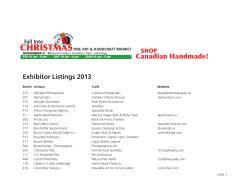
Davenport Laroche GeMS report aprIL 2015
Davenport Laroche GEMS Report APRIL 2015 China’s Role in the Gemstone Industry As China has become a global economic powerhouse and the second largest economy in the world, it has also had a major impact on the state of the global gemstone industry, both as a consumer and producer nation. This edition of the Davenport LaRoche Gemstones Feature is set to analyse the effect that China has had on gemstones and the potential impact it may have in the future. China’s Demand for Gemstones and Jewellery China has experienced one of the strongest economic growth rates ever following the decision to reform its economic and political systems in 1978. This expansion has driven a rise in wages across the country, and therefore boosted the spending power and affordability of luxury goods. A number of other phenomenon are taking place amongst Chinese consumers. The highest growth potential lies in the inland urban centres, as Chinese citizens continue a massive migration from rural areas to the cities. Chinese consumers are becoming more knowledgeable about gemstones and jewellery and more astute in their purchases. They have a keen sense of both value and brand trust, and they have become more open to contemporary and Western designs and materials. In 2014, despite falling by 5.4%, the imports of jewellery into Hong Kong were worth a staggering HK$222.68 billion ($28.72 billion). Furthermore, 2015 has seen a strong start and recovery for the industry with demand rising by 29% in February, alone. From January to February, exports in this sector increased 12.6% to HK$33.075 billion ($4.26 billion). China’s increasing demand for jewellery and gemstones is being experienced around the world. For example, in India, the Mumbai diamond market is prospering, largely as a result of the rise of Chinese consumers. Chinese buyers are flocking to the western business district of Bandra-Kurla Complex to buy diamonds from wholesale sellers. There is also a rise in the number of high-net worth investors across the Dragon Economy who are turning to diamonds and other gemstones to protect their wealth and generate income. According to the China Ultra High Net Wealth Report 2014-2015, almost half of China’s wealthiest prefer to invest in jewellery and jade. China’s Production of Gemstones and Jewellery To ensure the competitive development and production of jewellery, China has a number of Special Economic Zones (SEZs) in which certain laws and regulations are relaxed to encourage the growth and expansion of their gemstone and jewellery developers and producers. The province of Guangdong, including Shenzhen and Panyu, has important SEZs for the diamond, gemstone, and jewellery industries. Many of the products manufactured in these zones are exported to the rest of the world through Hong Kong. The Chinese industries have also benefitted from the country being accepted into the World Trade Organisation in 2001 which has provided greater access to the global marketplace for the Dragon Economy. In October 2000, the Shanghai Diamond Exchange (SDE) was established. Prior to that, taxation—including tariffs, VAT, and sales tax on diamond imports—was very high, around 35% to 40%. Polished diamonds now only pay VAT of 4% whilst if the rough is polished in China and returned to the country of export, then no VAT is applied. The growth of the Chinese economy has had a huge impact on the global gemstone industry both in terms of demand and supply. China’s burgeoning middle class is demanding gemstones and jewellery for both personal and investment purposes whilst the country’s industries compete globally. http://bit.ly/1zFL7Cv To find out more about hard assets trading, contact one of our consultants: Address: 1501, Millenium City 5, 418 Kwun Tong Road, Kwun Tong Kowloon Phone Number: +852 35655962 Fax Number: +852 37538919 Email: info@davenportlaroche.com
© Copyright 2025





















